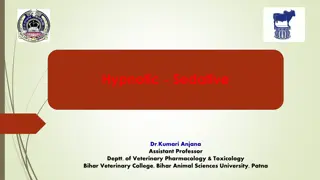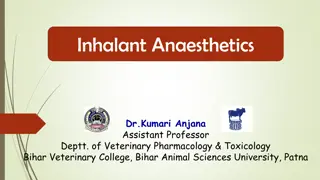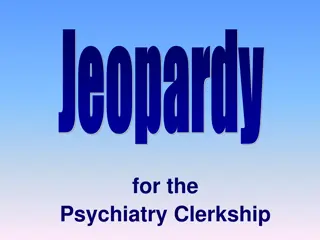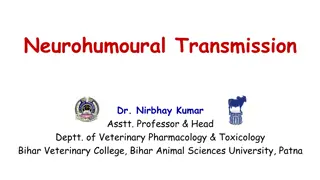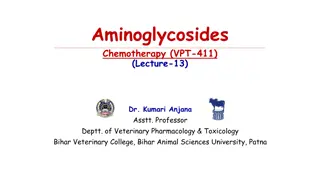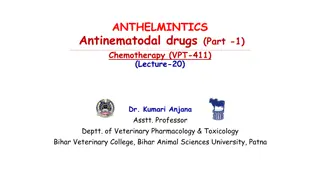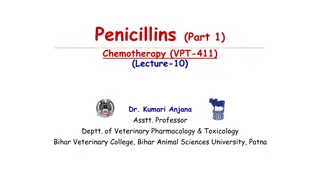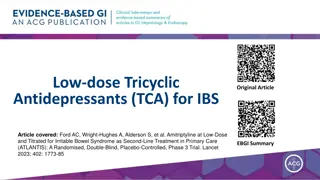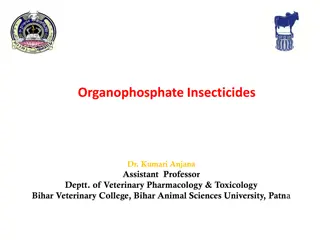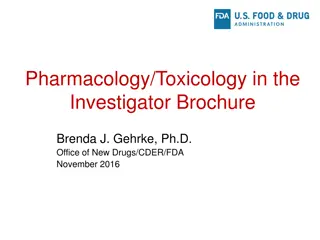Understanding Antipsychotics and Antidepressants in Veterinary Pharmacology
Antipsychotics and antidepressants play crucial roles in treating psychological and affective disorders in veterinary medicine. Antidepressants are vital in managing abnormal mood and behavior linked to depression, while antipsychotics help address various nervous disorders. The classification of antidepressants includes tricyclic antidepressants, MAO inhibitors, and 5-HT reuptake inhibitors. Each type acts through different mechanisms to alleviate symptoms and restore neurotransmitter balance in the brain.
Download Presentation

Please find below an Image/Link to download the presentation.
The content on the website is provided AS IS for your information and personal use only. It may not be sold, licensed, or shared on other websites without obtaining consent from the author. Download presentation by click this link. If you encounter any issues during the download, it is possible that the publisher has removed the file from their server.
E N D
Presentation Transcript
ANTIPSYCHOTICS Dr. Kumari Anjana Assistant Professor Deptt. of Veterinary Pharmacology & Toxicology Bihar Veterinary College, Bihar Animal Sciences University, Patna
ANTIPSYCHOTICS These drugs are used in psychological disorders or affective disorders. Affective disorders characterized by abnormal mood. The abnormal mood changes are: 1) Depression and 2) Mania. Therefore, these drugs are of two types: 1) Antidepressants and 2) Antimaniac drugs are nervous disorders
Antidepressants Are drugs used in the treatment of abnormal mood and behavior due to depression. These drugs are also called as Thymoleptics or Mood Elevators. Depression is characterized by feeling of sadness or misery, loss of concentration disinterest in surroundings, loss of libido, anorexia, lowered energy and insomnia (sleeplessness) or hypersomnia (excessive sleep). Pharmacologically it is due to deficiency of monoamines in limbic system in brain. Depression is treated by administering antidepressants. or self-confidence,
Classification of Antidepressants Tricyclic Anti-depressants : Impramine, Protriptyline, Clomipramine, Amoxapine, Trazodone, Monoamine Oxidase (MAO) Inhibitors- Phenelzine, Tranylcypromine Moclobemide, Iproniazid, 5-HT re-uptake Inhibitors- Fluoxetine, Fluvoxamine, Sertraline, Citralopram, Desipramine, Amitriptyline, Doxepine, Nifazadone, Mitrazapine, Maprotilne. Isocarboxazid, Selegiline. Paroxetine, Reboxitine, Paroxetine.
Classification of Antidepressants: Tricyclic Anti-depressants: NA+5 HT reuptake inhibitors- Impramine, Protriptyline, Amitriptyline, Doxepine, Clomipramine, Mitrazapine, Nifazadone, Trazodone, Maprotilne. Predominantly NA reuptake inhibitors- Desipramine, Nortriptyline, Amoxapine, Reboxetine. Monoamine Oxidase (MAOA) Inhibitors-- Phenelzine, Tranylcypromine Isocarboxazid, Moclobemide, Iproniazid, clorgyline (MAOB) Inhibitors - 5-HT re-uptake Inhibitors- Fluoxetine, Fluvoxamine, Paroxetine, Sertraline, Citralopram, Reboxitine, Paroxetine. Selegiline.
Mode of Action Tricyclic Anti-depressants- Act by inhibiting uptake of noradrenaline and/or 5-HT by monoaminergic nerve terminals, thus acutely facilitating transmission. Monoamine Oxidase (MAO) Inhibitors-- Inhibit one or both forms of brain MAO: Increase stores of noradrenaline, dopamine and 5-HT in nerve terminals. Inhibition of both MAO types correlates with antidepressant activity. 5-HT re uptake Inhibitors-- Act by inhibiting uptake of 5 HT by tryptaminergic nerve terminals, thus acutely facilitating 5- HT transmission.
MAOA norepinephrine and MAOB is specific to dopamine and 5- HT. Cheese, wine and chocolate contain tyramine, which degraded in liver by MAOA before systemic absorption. Ingestion of these foods in patients under MAO inhibitor antidepressant therapy results in server hypertensive crisis (Tyramine is adsorbed and taken up by the adrenergic nerves, converted to octopamine, a false transmitter, which releases norepinephrine from adrenergic nerve terminals). enzyme is specific to epinephrine and
Antimaniac Drugs Mania is characterized by excessive exuberance, enthusiasm, over self-confidence, easy irritability, aggressive behavior or hyperactivity and improper judgement. Pharmacologically it is due to dopaminergic over activity in the limbic system in brain. Drugs for treatment of mania are: 1) Lithium carbonate, 2) Carbamazepine and 3) Valproate. These drugs are also called as mood stabilizing drugs.
Lithium carbonate Lithium is a small monovalent cation (Li+). Lithium readily enters excitable cells through the Na+ channels displacing intracellular K+ and is nearly equally distributed inside and outside the cells (Na+ and K+). The influx of K+ is reduced by inhibition of Na+/K+ ATPase and the electrical gradient of K+(increased extracellular K+ level). The reversal of K+ levels results in lowered neuronal excitability causing calming of the maniac individual.
Lithium carbonate contd It also reduces release of norepinephrine and dopamine in brain, without affecting 5-HT release. Lithium is also believed interfere with the transduction mechanisms of central adrenergic receptor activation through decreasing the formation of second messenger cAMP and IP3. Thus, lithium is acting through decreasing neuronal excitability and correcting the imbalance of turnover and/or actions of monoamines in brain.
Thank You Thank You





